
Steamboat Engravings - Page 4
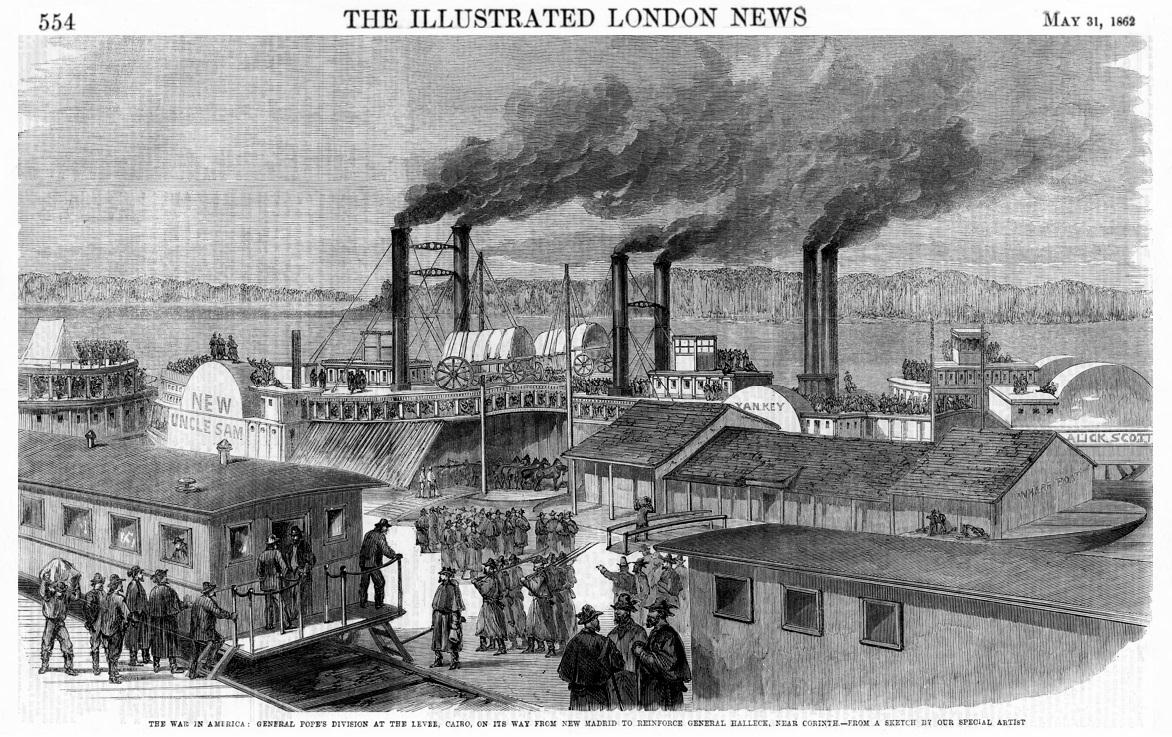
Confederate Prisoners and the Aleck Scott, February 1862
Illustrated London New 21 May 1862
Civil War in America - Steamboats at Cairo, Illinois
"THE WAR IN AMERICA: GENERAL POPE'S DIVISION AT THE LEVEE, CAIRO (THE ILLINOIS TOWN ON THE MISSISSIPPI AT THE MOUTH OF THE OHIO RIVER) ON ITS WAY FROM NEW MADRID TO REINFORCE GENERAL HALLECK, NEAR CORINTH."
The names of three of the boats are legible although two of the names were misspelled. The NEW UNCLE SAM is O.K. The "YAN KEY" should have been spelled "YANKEE" and the "ALICK SCOTT" should have been spelled "ALECK SCOTT" which was the steamboat that young Sam Clemens was on board "learning the river" as a cub pilot under Horace Bixby from December 1858 to April 1859.
The online article below quotes a letter written by a Union soldier's wife to her husband in February, 1862 describing Confederate prisoners on board the ALECK SCOTT who were guarded by Union soldiers on the Mississippi at Liberty, Illinois.
From "Raiders of the Lost Archives":
wordpress
Behind the stacks at the Special Collections Research Center
Morris Library
Southern Illinois University
Carbondale, Illinois
Posted by: Aaron Lisec | March 6, 2012
Confederate Prisoners and the Aleck Scott, February 1862
Nancy Clendenin Mann (1829-1912) lived in Liberty (now Rockwood), Illinois, a small town on the Mississippi River about ten miles below Chester. During the Civil War her husband John served in the Fifth Illinois Cavalry. Nancy kept house and raised their four daughters. Her letters to John kept him informed about town news, the girls' activities and health, the price and availability of local commodities, and news of friends and relatives in other regiments.
Looking out on the busy Mississippi, Nancy sometimes witnessed scenes that brought the war to her doorstep. On February 20, 1862, she watched as five boatloads of Confederate prisoners, captured at the surrender of Fort Donelson on February 16, passed Liberty on their way to prison camps at Camp Butler in Springfield or Camp Douglas in Chicago. Nancy wrote a breathless description for her husband, who had barely finished training camp and seen nothing yet of the war.
"My eyes are so tired with looking through the spy glass at rebel prisoners that I can scarcely see to write. The steamboat Alex. Scott is laying at Hamilton's wood yard, laden with prisoners taken at Fort Donelson. Emily, Nannie and I, have been looking through the glass at them. They are clad in dirty looking garments of various colors. They have no uniformity of dress, they do not have overcoats but wear a blanket with a hole in the center through which they put the head. This gives them a very slovenly appearance. The blankets are some red, some striped, some white, the dirtiest things you ever saw. The men walk, or sit, around on the boat. They do not make a very lively appearance. Our men who are guarding them on the boat step round with their heads up and try keep themselves warm. You will never know what a contrast there is between the Union loving men and the rebels until you see them together, . . ."
(Mann Family Papers; punctuation and capitalization corrected)
Launched in 1848, the steamboat ALECK SCOTT plied the Mississippi for more than a decade. Samuel L. Clemens served as cub pilot on the boat from December 1858 to April 1859, making five trips between St. Louis and New Orleans. After the fifth trip Clemens acquired his pilot's license, having worked two years on the river. The dates and boats he served are chronicled here by the Mark Twain Project at the University of California at Berkeley.
Pressed into Union Army service as a quartermaster ship in 1861, the ALECK SCOTT was renamed FORT HENRY after February 1862. In September 1862 the ship was converted to an ironclad, renamed LAFAYETTE and transferred to the Navy.
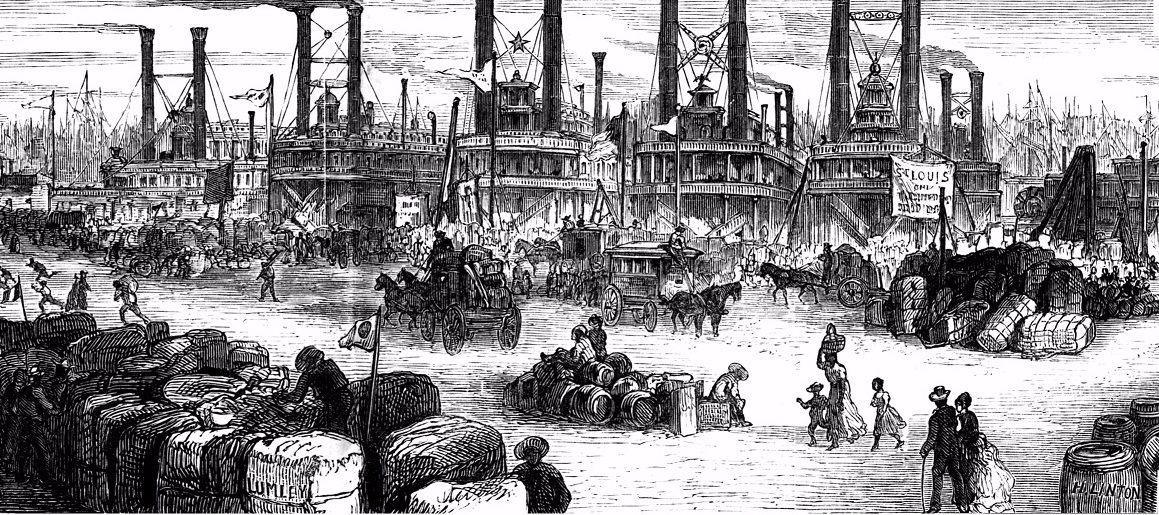
New Orleans Levee LONDON NEWS 24 SEPT 1881
Detail from the lower center panel on pages 312 & 313
of the ILLUSTRATED LONDON NEWS 24 SEPT 1881 page of 11 engravings
"AMERICAN COTTON - It's cultivation and Preparation in Mississippi"
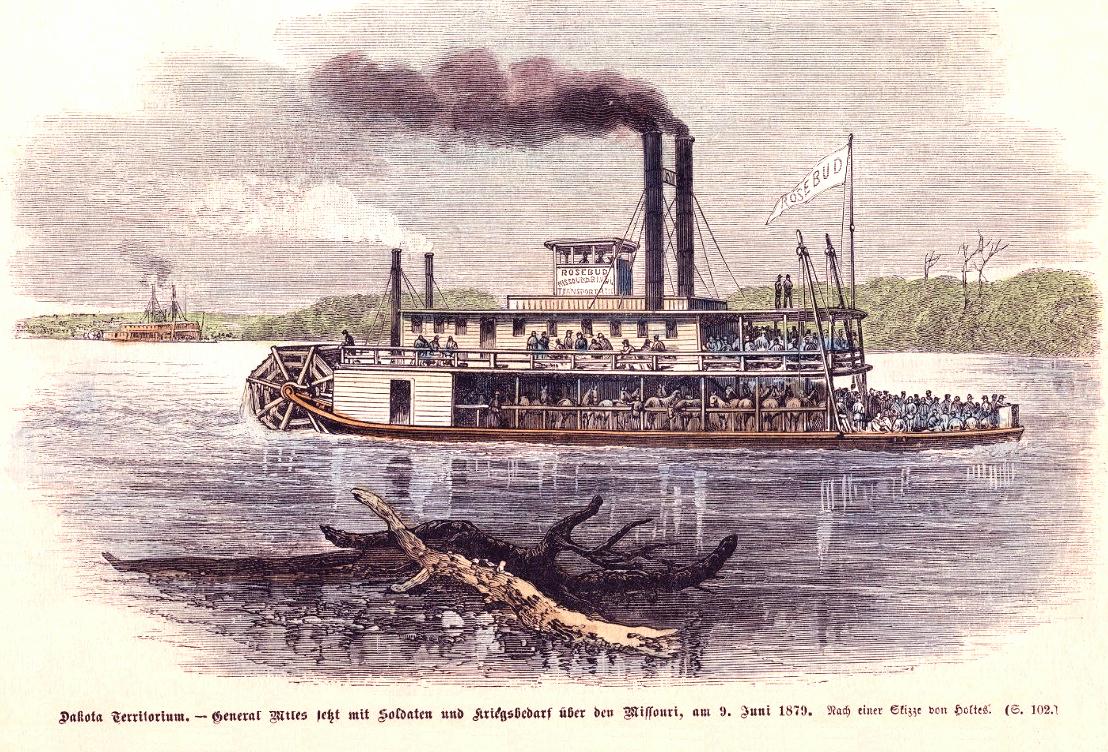
Steamboat ROSEBUD on the Missouri River
Steamboat on river with many men and horses on the two decks.
Signboard on starboard side of Pilot House:
'ROSEBUD Missouri River transportation'
Other steamboat in distance near shore, likely the DAKOTA.
German caption: "Dakota Territorium. -- General Miles setzt mit Soldaten und Kriegsbedarf über den Missouri, am 9. Juni 1879. Nach einer Skizze von Holtes. (S. 102) -
Translation of German text: "Dakota Territory. General Miles moves troops and war supplies across the Missouri on June 9, 1879." Sketch by Holtes. (P. 102)"
The New Campaign Against Sitting Bull:
General Nelson A. Miles was assigned to organize and put in motion a strong column to drive invading Indians back. The famous young Indian fighter proceeded to established his supply depot at Old Fort Peck, using the steamers ROSEBUD and DAKOTA in gathering his men and materials. On the 8th of June, 1879 two companies of the Sixth Infantry arrived at the camp, and a few hours later the DAKOTA appeared with supplies of all kinds for the expedition.
Digital Horizons Life on the Northern Plains - Dakota Lithographs and Engravings - North Dakota State University
digitalhorizonsonline.org
Image in public domain.
Credit Line Institute for Regional Studies, NDSU, Fargo (Folio 102.TrS73.1)
Original Source Lithograph from unknown source, perhaps Leslie's magazine. Item Number Folio 102.TrS73.1. In consequence of the reports that bands of Sioux from Sitting Bull's encampment in Canada had crossed the line, the while ostensibly hunting buffalo were raiding isolated white settlement, orders were issued in the latter part of June to General Nelson A. Miles to organize and put in motion, with all haste, a strong column to drive the Indians back. With his accustomed alacrity the famous young Indian fighter proceeded to execute his orders, and as we write has already had an encounter with the invading hostiles. He established his supply depot at Old Fort Peck, using the steamers Rosebud and Dakota in gathering his men and materials. On the 8th of June two companies of the Sixth Infantry arrived at the camp, and a few hours later the Dakota appeared with supplies of all kinds for the expedition. On the morning of the 9th his scouts reported at the south bank of the Missouri. Throughout that day the boats were engaged in transporting troops, friendly Indians, guns, ammunition, etc., to the north bank. General Miles took his departure from Fort Benton, July 14th, with 800 men. He left a guard at Fort Peck and four companies at Mussel Shell, and started north with the rest. He has with him a battery of six Rodman and Hotchkiss guns, 140 boxes of shell, 22,000 rounds of revolver cartridges, 200,000 rounds of rifle cartridges, twenty-five travois and several ambulances.
The first intelligence from the moving column was in the form of a dispatch from Fort Keogh, which said an engagement took place near the mouth of Beaver creek on the 17th, between two companies of troops and Lieutenant Clark's Indian scouts of General Miles's command, and 300 hostile Sioux. The troops lost four Indian scouts killed, and two soldiers were wounded. When General Miles's main column, which was twelve miles behind, came up, the Indians were pursued fifteen miles, but made their escape to Sitting Bull's camp, which was but a few miles off, and on this side the line. Bear Wolf's band of Crows, who are at Terry's Landing, report 300 lodges of Sioux on this side of the Missouri, on their way to Keogh to make friends with the whites. On July 24th, Secretaries McCrary, Thompson and Schurz had a conference at the War Department with regard to the present Indian outlook in the Northwest. They were unanimously of the opinion that every precaution to prevent hostilities with the Indians should be taken, and as positive orders have been sent to General Miles to proceed cautiously and quietly, and not to bring on a war, no serious conflict is anticipated, although, of course, it cannot be known what action Sitting Bull may take should he perceive the soldiers near the Canadian line. It is thought to be the intention of General Miles to approach the border with a view to reconnoitering Sitting Bull's camp. With reference to the reports from American sources that Sitting Bull's band is on the warpath, the Canadian Department of the Interior does not credit any such rumors.
Recent advices from the northwest say that Sitting Bull and his men are peaceably inclined. Their relations with the mounted police were never more satisfactory. It is believed there that General Miles has been misled by the traders and scouts, who are always anxious for a fight. All is quiet within the Canadian territory."
Article accompanying image, publication unknown.
Notes Title provided by staff.
Artist unknown.
"Dakota Territory. General Miles moves troops and war supplies across the Missouri on June 9, 1879." Sketch by Holtes. (P. 102)" - Translation of German text. Contributor Holtes, Charles Contributor Role Illustrator Repository Institution North Dakota State University Libraries, Institute for Regional Studies Repository Collection Dakota Lithographs and Engravings Collection Folio 102 Collection Finding Aid Consult: hdl.handle.net
Rights Management Image in public domain. Language ger; Digital ID rsL00090
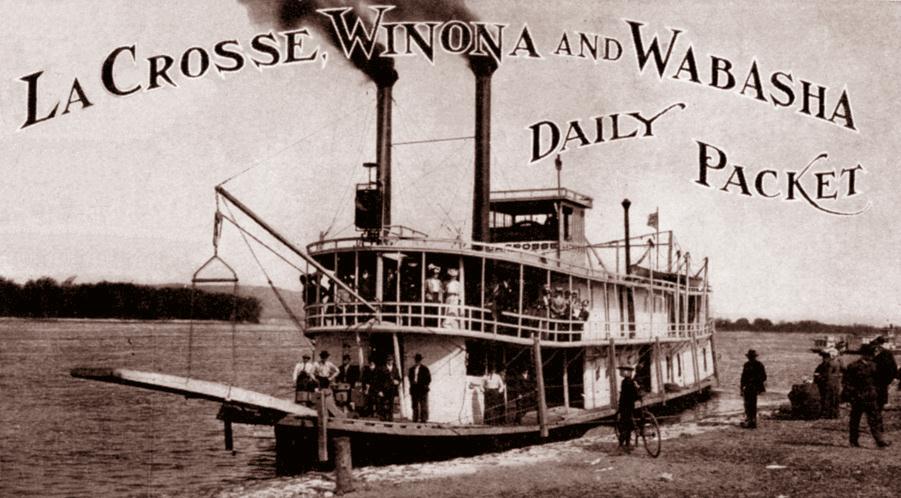
Steamboat LA CROSSE the La Crosse, Winona & Wabasha Daily Packet
Promotional printed card for the Steamboat LA CROSSE which was the La Crosse, Winona & Wabasha Daily Packet.
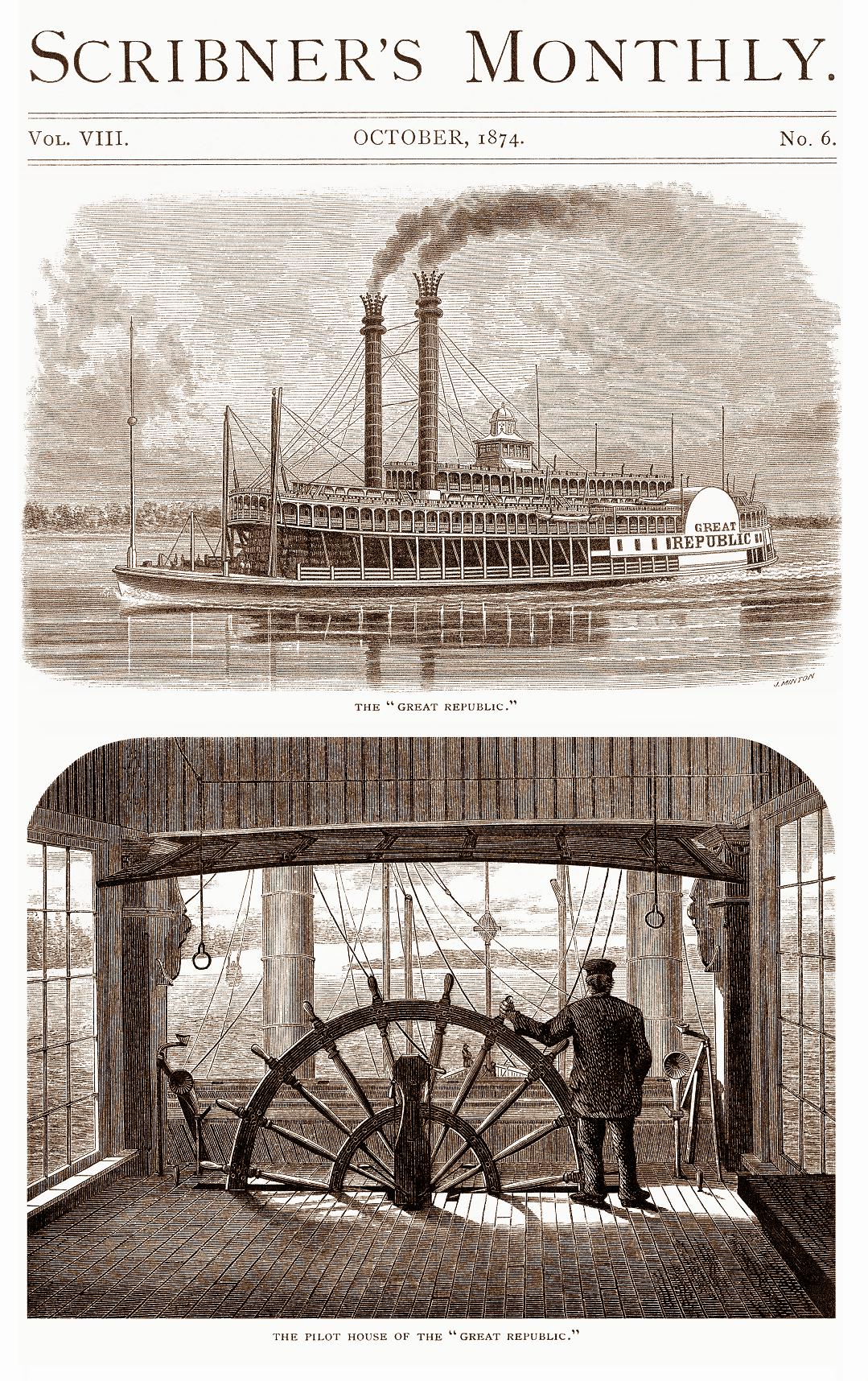
You're probably familiar with this . . . Pilot house of the Great Republic from Oct 1874 Scribner's Monthly from a series of articles about "The Great South", this was called Down the Mississippi.
I made a high rez scan and improved the distant boat visible on the left side and slimmed down the pilot who was about a third bigger in the engraving. I imagine the original drawing by J. Wells Champney that this was based on, was probably quite a bit better than the engraving but who knows what became of it? - Dave
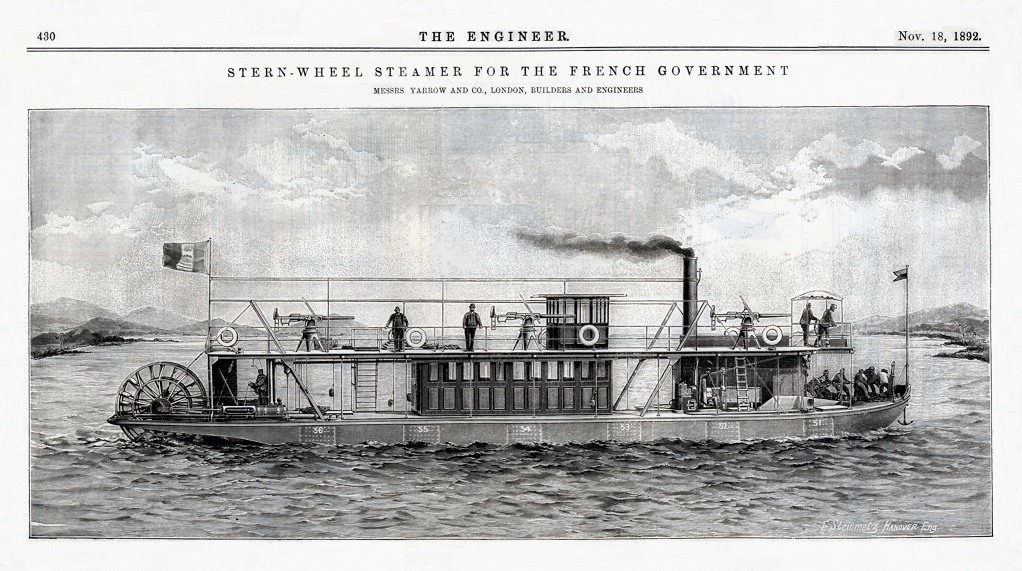
The Sternwheel gunboat OPALE built in London, England for the French military in 1892
"ARMED" STERNWHEELERS ASSIGNED TO MILITARY EXPEDITIONS ON RIVERS IN WEST AFRICA. THE "OPAL" WAS BUILT IN THE UK FOR THE FRENCH IN A CAMPAIGN AGAINST THE DAHOMEYANS IN 1892
THE ENGINEER. Nov. 18, 1892.
STERN-WHEEL STEAMER FOR THE FRENCH GOVERNMENT
MESSRS. YARROW AND CO., LONDON, BUILDERS AND ENGINEERS
Here we have an illustration of a shallow-draught gunboat, constructed in the spring of this year for use in the expedition against the Dahomeyans by the French Government. Tenders for this vessel were first invited from French builders, but the time demanded for the construction by the various firms was so long that the vessel would probably not have been ready until after the war was over, from four to ten months being required for completion by the firms in that country. Under these circumstances the French authorities applied to Messrs. Yarrow and Co., who are justly celebrated for the construction of shallow river steamers ; they, in response, offered to construct a vessel to fulfill the required conditions in one month, and they selected the stern-wheel type as in their opinion the most suitable. The order was ultimately placed in their hands, and, as a matter of fact, the vessel was delivered, after trial on the Thames, complete in every respect, in the marvelously short space of twenty-three working days, having been commenced on April 28th, and completed on May 23rd.
The OPALE is 100ft. in length by 18 ft. beam, and was built on a system introduced and patented by Messrs. Yarrow and Co. She was constructed in seven floatable sections, arranged in such a manner that each section when lowered into the water from the transporting vessel will float independently. These sections when bolted together, which can be readily and quickly done, then form the hull, on which the boiler and machinery are lowered and connected up, making the complete steamer.
The operation of lowering the sections and coupling them up ready for working can be done in as many hours as it would take weeks to rivet the boat up if sent out in separate plates and frames as usual; consequently, when transported is of primary consideration, the system adopted is specially desirable. The propelling machinery consists of a locomotive boiler placed in the forward part of the boat, so as to counterbalance the engines and paddle wheel, which are situated at the stern. These latter consist of a pair of simple high-pressure engines laid horizontally, working direct on to the paddle shaft, which is carried on hollow tubular girders, the after ends of which are supported by two cantilevers. The general arrangement of the OPALE's machinery is so simple and easily understood from the engraving that it is quite unnecessary to describe it in detail. There was provided a fresh water distiller for the supply of pure drinking water, which is essential for the health of the crew, when navigating the rivers of West Africa. The whole of the hull and truss work belonging to the vessel are constructed of mild steel, which admits of ample strength being obtained with a draught of only 18 inches in average trim.
The cabin work comprises accommodation for European officers and crew on the main or lower deck, and besides this there is a cabin on the upper deck for the captain. The armament consists of four rifle caliber quick-firing guns, on the upper deck, which secures a good range over the river banks, and has been found of great service in actual practice when attacking the natives, who hide themselves in the long grass. On the main or lower deck there are provided three 37mm Hotchkiss revolving cannon.
The steering wheel is placed well forward on the upper deck, and we may state that as stern wheelers always are provided with more than one rudder, and as the hull both at the bow and stern below water is well cut away, their steering qualities are superior to what are found in any other class of vessel, enabling them successfully to navigate narrow, winding, and rapid rivers.
The official trial of the OPALE took place on the river Thames in the presence of Captain Le Clerc, Naval Attaché to the French Government, and M. Revol, naval engineer, the speed attained by six runs over the measured mile at Long Reach being slightly in excess of the contract speed of ten statute miles an hour, wood only being used for the trial, of which the consumption was four hundred weight per hour.
The OPALE has deck space sufficient for the conveyance of 400 troops, and will carry about 2 1/2 tons for every inch increased draught beyond 18 inches.
With the permission of our Government, the OPALE was assembled in British waters on the West Coast of Africa, whence she steamed up through the lagoons into the interior, where she has done, and is still doing, excellent service, to the entire satisfaction of the French authorities.
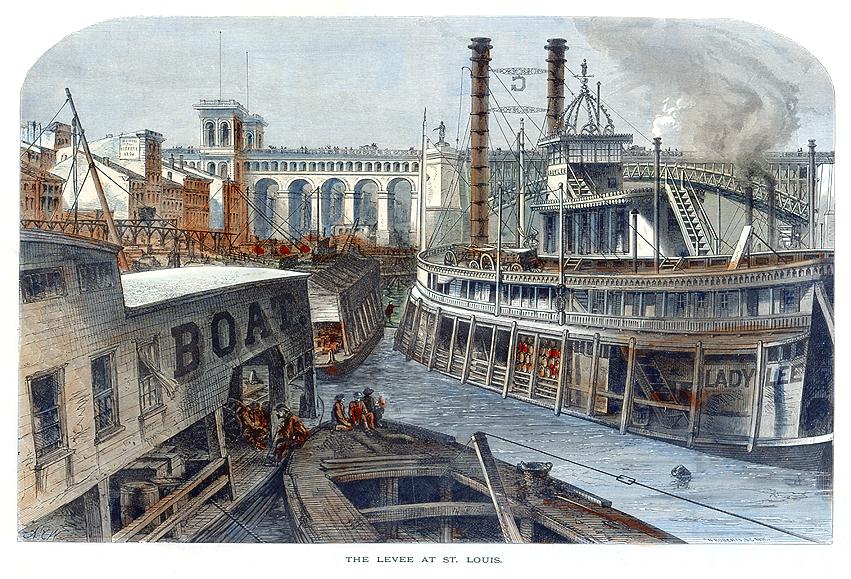
Have had this framed downstairs for decades and finally got around to scanning it though the glass in the frame.
This is another engraving from a drawing by A.R. Waud, also hand painted by someone, probably during the 20th century.
The Levee at St. Louis 1872 from Picturesque America, published by D.Appleton, NY. 1873
Some history on the steamboat below courtesy of Lewis Verduyn on his Steamboat Times site: steamboattimes.com
LADY LEE and wharf boat with the Eads Bridge in the background. Construction of the bridge began in 1867 and was completed in 1874. At the time of this etching in 1872, the stone approaches would have been in place and the steel arch work well advanced.
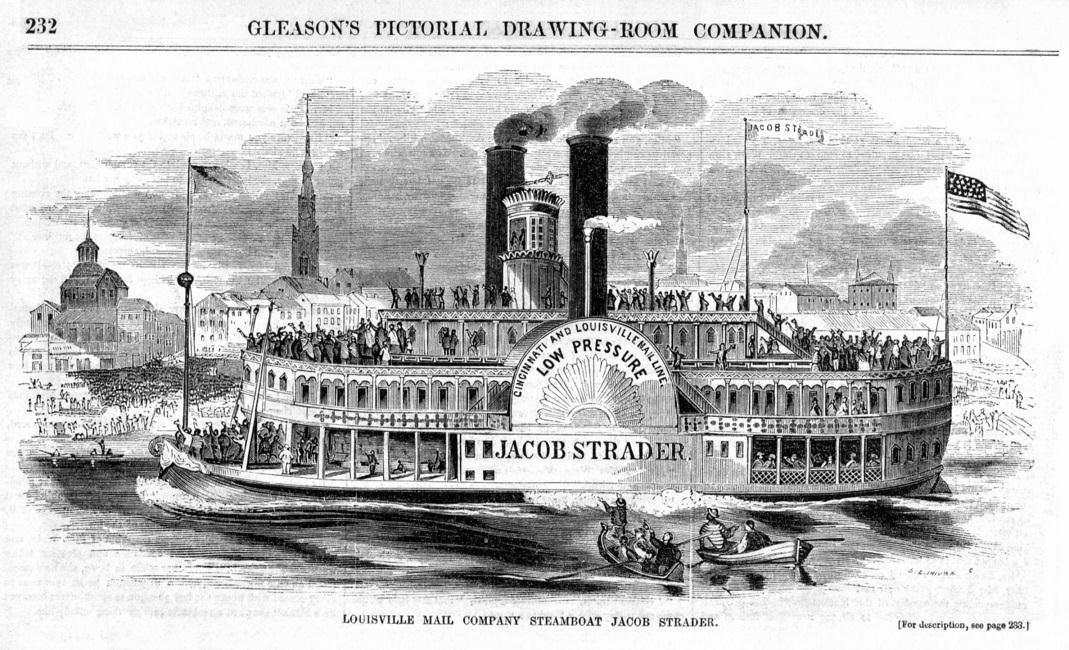
1854 engraving of the steamer Jacob Strader Gleason's Periodical
From Wikipedia:
The JACOB STRADER was a sidewheel packet steamboat built in Cincinnati, Ohio in 1853 that we have a photo of a painting that Robert Hagemann made back in the 80's that we have with some frame captures from the German TOM SAWYER in which the digital steamboat in that movie also had its smokestacks behind instead of in front of the pilot house. We should also have a photo of the boat itself from La Crosse but I'm not sure what page it's on.
The STRADER was owned by the U.S. Mail Line of Cincinnati. She provided the ultimate in luxurious travel between Cincinnati and Louisville up to the time of the Civil War.
She was described as by Thomas Nichols, a writer and traveler of that time, as "the finest boat, all things considered, that I ever saw on the American waters."
The Strader Steamboat Company operated 23 riverboats in these waters based at Strader Wharf, located at the foot of Vine Street in Cincinnati. During the Civil War the Jacob Strader side wheel packet was used to transport sick and wounded soldiers. The Jacob Strader was dismantled in Madison, Indiana in 1866.
Captain Jacob Strader (August 5, 1795—August 28, 1860), after whom the steamboat was named, was a prominent businessman in Cincinnati as well as a partner in the U.S. Mail Line.
His enterprises included banking as well as the Little Miami Railroad and the Xenia Railroad companies. Jacob Strader died in 1860.
He is entombed in a notable Gothic style brownstone mausoleum at Spring Grove Cemetery.
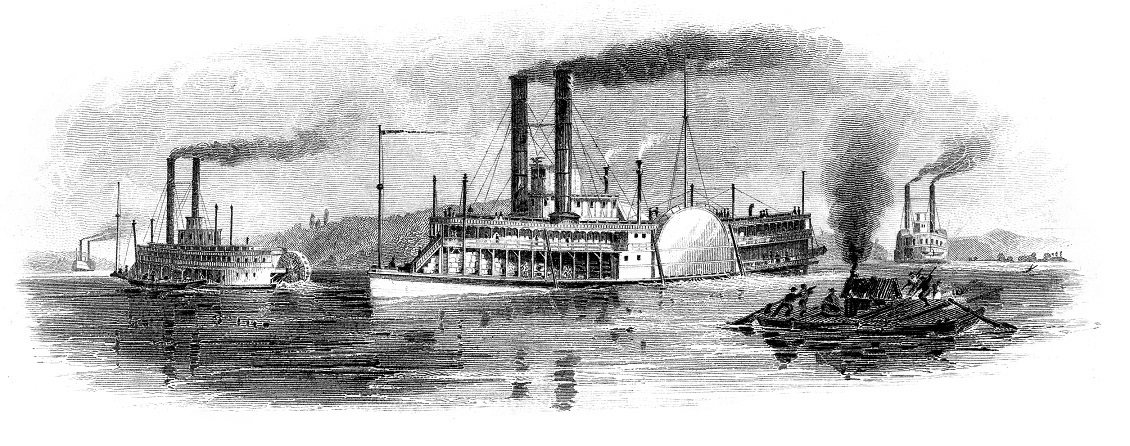
Four steamboats (if you include the tiny one on the far left) were depicted in this panoramic engraving that was the banner illustration running along the top of a vintage Arkansas Levee Bond.
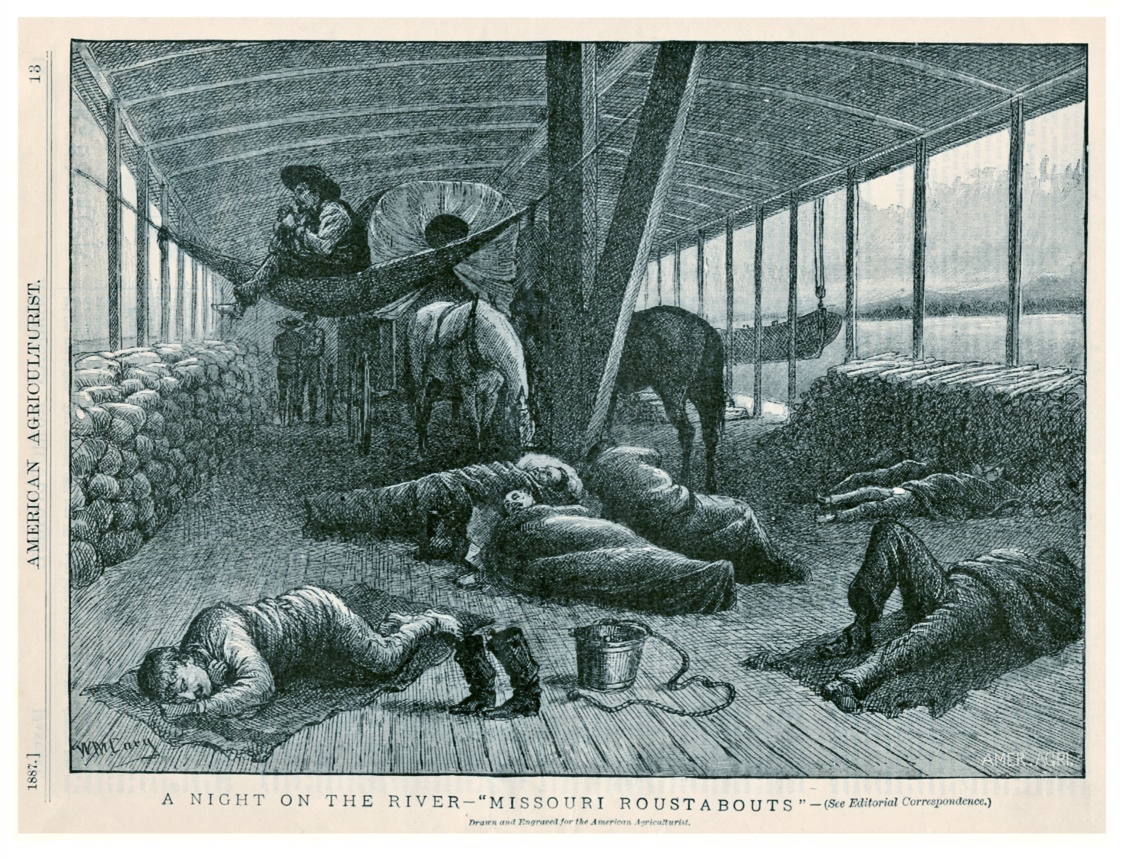
Page 13 from an unknown month of the 1887 publication, AMERICAN AGRICULTURALIST
A NIGHT ON THE RIVER - "MISSOURI ROUSTABOUTS" - (See Editorial Correspondence).
Signed in lower left W.M. Cary (William de la Montagne Cary. 1840-1922) who probably also wrote the text that is referred to in the caption as appearing on the "Editorial Correspondence" page of this issue which was not included with this purchase. If I'm ever able to locate the commentary I will transcribe and send it along to expand this caption.
The "Rousters" are sleeping where ever they could on the main deck of a steamboat, probably on the Missouri River. The gent in the hammock appears to have the most comfortable bunk. The two horses and the covered wagon in the background add to the pictorial interest and depth of the picture.
Cary's scenes of the American West began appearing during the late 1860's in Harper's Weekly, Frank Leslie's Illustrated Newspaper and periodicals like the American Agriculturalist. Cary based his drawings on his own first hand experiences Out West. I got the impression that he not only made the original drawings but also made the engravings that were published in the periodicals. In style his graphics are reminiscent of those made by True Williams who illustrated the first edition of Mark Twain's TOM SAWYER in 1876.
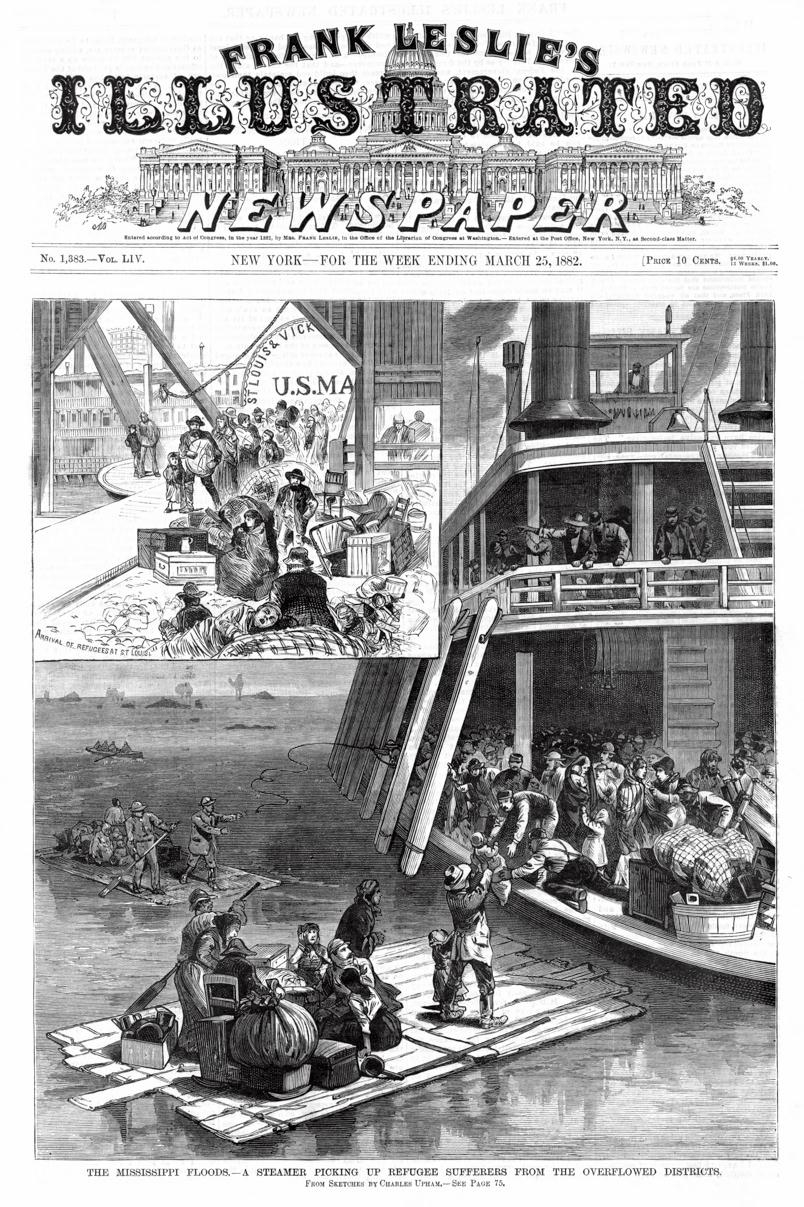
This March 25, 1882 cover from sketches by Charles Upham is one I've always liked and finally found one.
Page 75 was not included, no pages outside of the cover were, so I don't have the article that pertains to the cover art.
Harper's Weekly published an article on the subject in their May 13, 1882 issue from which I extracted 2 paragraphs of useful history. Have provided the link to the article for those who would like to read the whole thing.
excerpt from
May 13, 1882, Harper's Weekly
The South Asking the Federal Government's Protection from the Unruly, Overflowing Monster Mississippi
nytimes.com
The great flood of 1882 ravaged communities along the Mississippi and Ohio Rivers and their tributaries. In Cincinnati, heavy rains began on Sunday night, February 19, 1882, and lasted for two days, causing the Ohio River to rise at a rate of two inches per hour. The flood blocked railroad tracks entering the city, submerged homes and factories, displaced hundreds of families and put thousands out of work temporarily. Similar scenes occurred along the Ohio in southern Indiana and Illinois.
Even more serious was the flooding along the Mississippi River, from Illinois and St. Louis virtually all the way down to the delta of New Orleans. The 1882 flood was one of the most devastating to the lower Mississippi River Valley. The water easily broke through most of the levees, burying entire towns, killing livestock and other animals, and forcing thousands of residents to flee for safety. In Arkansas alone, an estimated 20,000 people were left homeless. In some places the overflowing Mississippi River transformed the adjacent communities into a lake, 15-miles wide. Private steamboat companies rescued those stranded by the flood, as did the Army Corps of Engineers and the Quartermaster Corps, which also distributed rations to the victims.
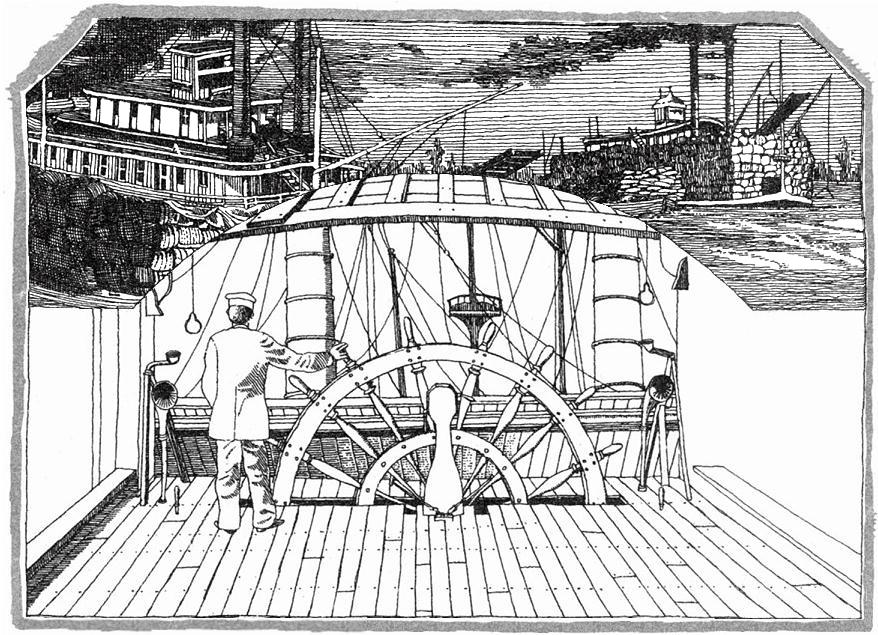
Ensikat based the pilot house interior on one of the engravings in the October 1874 issue of Scribner's Monthly that we also have posted among the illustrations.
The high angle and low angle cotton packets above the pilot house look familiar and appear to have been derived from vintage photos or illustrations.
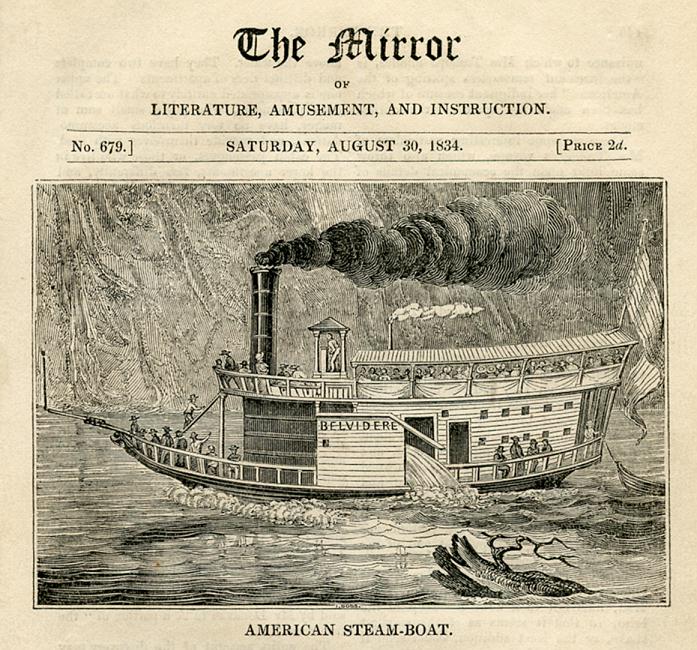
Attached is a scan of the quaint graphic of the Belvidere and a transcript of the review of the U.S. "steam-boat" passage from "Mrs. Trollope's" 1832 travelogue DOMESTIC MANNERS OF THE AMERICANS that accompanied it.
Mrs. (Frances Milton)Trollope begins her account of the "steam-boat" journey from New Orleans to Cincinnati by way of Memphis in Chapter 2: "On the first of January, 1828, we embarked on board the Belvidere, a large and handsome boat . . ."
Mrs. Trollope's book can be read in its entirety on Project Gutenberg: gutenberg.org
THE MIRROR
OF
LITERATURE, AMUSEMENT, AND INSTRUCTION.
No. 679.
SATURDAY, AUGUST 31, 1834.
PRICE 2d.
Mrs. TROLLOPE, in one of the lithographs which accompany her otherwise graphic sketches of American mariners, has furnished the original of the above Engraving.
It represents the Belvidere, a large and handsome boat, in which our lady-traveller voyaged [This is an awkward term, but sailing can scarcely be applied to a steam-boat passage. A Thames captain would, perhaps, call it steaming.]from New Orleans to Memphis, along the vasty Mississippi river.
Yet Mrs. Trollope does not describe this as the largest or handsomest of the many steam-boats which displayed themselves along the wharfs ; and, in a sentence for which even the Americans will thank the writer, she observes :
"The innumerable steam-boats, which are the stage-coaches and fly-wagons of this land of lakes and rivers, are totally unlike any I had seen in Europe, and greatly superior to them."
The fabrics which they most resemble in appearance are the floating baths, (les Latins Vigier;) at Paris. [These are stupendous baths kept by one Vigier. They are stationed in different parts of the Seine. That above the Pont Royal, (have they discarded this name?) opposite the Tuileries, is the most spacious and elegant. It was built in forty days, on a boat as long as the largest vessel. It is two stories high; the galleries are adorned with pillars, pilasters, and handsome ceilings; and it contains 160 baths.]
The annexed drawing will give a correct idea of their form.
The room to which the double line of windows belongs, is a very handsome apartment before each window a neat little cot is arranged, in such a manner as to give its drapery the air of a window-curtain.
This room is called the gentlemen's cabin, and their exclusive right is somewhat uncourteously insisted upon.
The breakfast, dinner, and supper are laid in this apartment, and the lady passengers are permitted to take their meals there.
Mrs. Trollope describes the room destined for the ladies dismal enough, as its only windows are below the stern-gallery; but both this and the gentlemen's cabin are handsomely fitted up, and the former well carpeted ; but," adds the writer, "oh! that carpet! I will not, I may not describe its condition; indeed, it requires the pen of a Swift to do it justice. Let no one who wishes to receive agreeable impressions of American manners, commence their travels in a Mississippi steam-boat." The nuisance to which Mrs. Trollope alludes, is "the incessant, remorseless spitting of the Americans," her indignant census, of which has been made the sport of the critical circles.
There are some interesting particulars of Mrs. Trollope's voyage, which also throw some light upon the economical details of the Belvidere.
The weather was warm and bright, and Mrs. Trollope found the guard of the boat, as they call the gallery that runs round the cabins, a very agreeable station; here Mrs. Trollope and her friend sat as long as light lasted, and sometimes, wrapped in their shawls, enjoyed the bright beauty of American moonlight, long after every passenger but themselves had retired.
The boat had a full number of passengers on board. The deck, as usual, was crowded with the Kentucky flat-boat men, returning from New Orleans, after having disposed of the boat and cargo which they had conveyed thither, with no other labour than that of steering her, the current bringing her down at the rate of four miles an hour. There were about two hundred of these men on board, and when the vessel was stopped to take in wood for finch, they ran, or rather sprang and vaulted over each other's heads to the shore, whence they all assisted in carrying wood to supply the steam-engine ; the performance of this duty being a stipulated part of the payment of their passage.
When the Mississippi is swollen at New Orleans, another traveller, Captain Basil Hall, likens it to a bowl filled tip to the brim, so that it seems as if the smallest shake, or the least addition, would send it over the edge, and thus submerge the city. The foot-path on the embankment is often but nine inches above the level of the stream; the colour of the water is of a dirty, muddy, reddish sort of white ; and the surface, everywhere strongly marked with a series of curling eddies or swells, indicative of great depth. Captain Hall likewise gives a brief description of the steam-boats which ply up and down the Mississippi ; and the passage may be supplementarily tacked to Mrs. Trollope's outline of one of these boats—the Belvidere.
"Thirteen enormous vessels of this description were lying along the banks of the river. One of these, called the Amazon, was just setting off for Louisville, in Kentucky, upwards of 1,400 miles distant, in the heart of the Continent, which they hoped to reach in ten or eleven days, though they had to go in the very teeth of the current.
"These boats are employed exclusively upon the river, where the water is always smooth, and where also they are well sheltered by the woods. These circumstances allow of their accommodations being raised to the height of twenty and sometimes nearly thirty feet above the water. They have two complete and distinct tiers of apartments. The upper one is appropriated entirely to what are called deck passengers, who pay a small sum of money, have no very luxurious accommodations, and provide themselves with food. The cabin passengers, or those who live in the lower apartments, fare differently, and are, of course, required to pay a higher sum for their passage.
"When the Amazon pushed off there could not have been fewer than 110 men standing on the roof, or deck, of the upper tier of berths, while in the lower gangways, passages, and balconies, or galleries, groups of ladies and gentlemen were moving about as if they had been in a fairy castle,—altogether a very lively and peculiar scene."

With the exception of images credited to public institutions,
everything on this page is from a private collection.
Please contact Steamboats.com for permission for commercial use.*
All captions provided by Dave Thomson, Steamboats.com primary contributor and historian.
